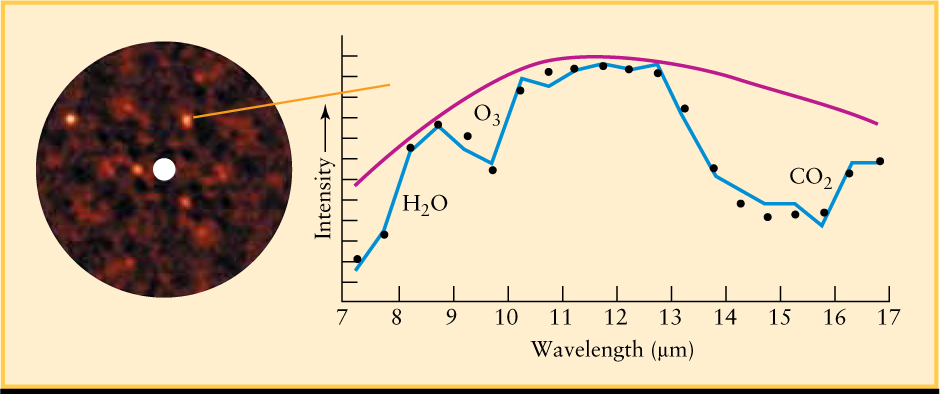27-6 Telescopes have begun searching for Earthlike planets
Although no longer involved in SETI, NASA is carrying out a major effort to search for Earthlike planets suitable for the evolution of an advanced civilization. Such a search poses a major challenge. One problem is that Earth-sized planets are too dim to be seen in visible light against the glare of their parent star. Using a different approach, astronomers have discovered many Jupiter-sized planets by detecting the “wobble” that these planets produce in their parent star (see Section 8-7). But a planet the size of Earth exerts only a weak gravitational force on its parent star. In 2009, the first Earth-sized planet (at 1.9 Earth masses) was discovered through a tiny wobble. However, this planet, named Gliese 581 e, orbits too close to its parent star to allow for liquid water. Furthermore, the wobble is so tiny that few Earth-sized planets are expected to be found using this technique.
Searching for Planetary Transits
An alternative technique was being used by an orbiting telescope called Kepler, which began detecting planets in 2009, and discovered hundreds of Earth-sized planets. Recall from Section 8-7, that if a star is orbited by a planet whose orbital plane is oriented edge-on to our line of sight, once per orbit the planet will pass in front of the star in an event called a transit (Figure 8-19). By blocking some of the star’s light, this transit causes a temporary dimming of the light we see from that star.
Once a transiting planet is detected, astronomers determine the transiting planet’s size (inferred from how much dimming takes place), as well as the size of its orbit. Recall from Johannes Kepler’s third law that the size of the orbit can be calculated using the orbital period of the planet, which is the same as the time interval between successive transits. Given the distance from the planet to its parent star and the star’s luminosity, astronomers will even be able to estimate the planet’s average temperature. However, this estimated temperature would not include the warming effects of an atmosphere without additional observations.
798
To determine a planet’s atmosphere, detailed spectra are required and these observations are only just beginning. It is important to keep in mind that just because a planet is Earth-sized and at a certain distance from its sun, it does not mean it is necessarily Earthlike. Finding a truly Earthlike planet with liquid water is difficult but could be discovered with the current generation of telescopes, or the next generation designed specifically for this goal.
CONCEPT CHECK 27-11
What exactly was the Kepler telescope watching for as it searched for planets around stars?
CONCEPT CHECK 27-12
Which planets were the Kepler telescope not able to find, even if quite nearby?
Searches Using Images and Spectra
The results from Kepler may help SETI and other astronomers select stars to study in more detail. But what comes next? NASA and the European Space Agency have studied how the next generation of telescopes might continue investigating Earthlike planets. These space agencies have proposed the Terrestrial Planet Finder (a system of telescopes) and Darwin (a spacecraft mission), but there is no funding for these missions as of this writing.
Studies suggest that a future telescope might search for Earthlike planets by detecting their infrared radiation. The rationale is that stars like the Sun emit much less infrared radiation than visible light, while planets are relatively strong emitters of infrared. Hence, observing in the infrared makes it less difficult (although still technically challenging) to detect planets orbiting a star.
This next generation of telescopes might also be able to measure a “biosignature” of life in a planet’s atmosphere. By analyzing the infrared spectra of potentially Earthlike planets, the telescopes could reveal the atmospheric composition from the unique absorption features of gases such as ozone, carbon dioxide, and water vapor (Figure 27-13). Ozone (O3) is made from ultraviolet sunlight acting on oxygen (O2), which could indicate the presence of life. This is significant not because oxygen sustains many life-forms on Earth (although it does), but because Earth’s oxygen-rich atmosphere was produced by living organisms, and does not seem attainable through nonbiological means. Therefore, oxygen is a key atmospheric biosignature that will be the target of future studies.

Future telescope technology may make it possible to resolve details on planets orbiting other stars
Sometime during the twenty-first century, we will probably answer the question “Are there worlds like Earth orbiting other stars?” If the answer is yes, then searches for life around other stars will gain even more impetus.
The potential rewards from such searches are great. Detecting a message from an alien civilization could dramatically change the course of our own civilization, through the sharing of scientific information with another species or an awakening of social or humanistic enlightenment. In only a few years our technology, industry, and social structure might advance the equivalent of centuries into the future. Such changes would touch every person on Earth. Mindful of these profound implications, scientists push ahead with the search for extraterrestrial intelligence.
CONCEPT CHECK 27-13
How does ozone act as a biosignature for life?
CONCEPT CHECK 27-14
Why not look for oxygen gas (O2) directly? Consult Figure 27-13.